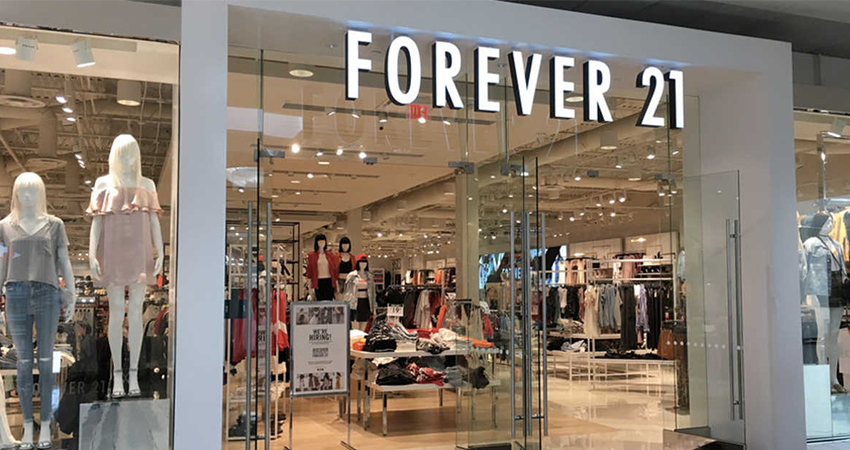Update as of 9/29/19: After months of speculation, Forever 21 announced it will file for Chapter 11 bankruptcy protection.
The New York Times reported the company will cease operations in 40 countries including Canada and Japan and close up to 178 stores in the U.S. and 350 overall. It will continue its website and operate the remaining U.S. stores as well as those in Mexico and Latin America.
“What we’re hoping to do with this process is just to simplify things so we can get back to doing what we do best,” Linda Chang, the chain’s executive vice president, told The New York Times.
According to the Times, ecommerce made up 16% of Forever 21’s sales, while overall revenue dropped to $3.3 billion last year, from $4.4 billion in 2016. It is expected that the restructured company will bring in $2.5 billion in annual sales.
“Still a very powerful brand that is more valuable than you would think a company entering bankruptcy would appear,” said Dave Bernstein, SVP, Retail Lead, North America at Publicis Sapient. “They understand digital is a force but still depended on the ‘give it to me right now’ of the fast fashion sector.”
Bernstein said he expects Forever 21 will recover from this, but it will take extra marketing work to get there. Its core customers are different 21-year-olds than they were 10 years ago. Topics never mentioned in 2010 like sustainability and social stance are now top of mind for younger consumers.
“Forever 21’s business model of an ever-changing display of what’s new is being eclipsed by firms like Rent the Runway and thredUP with business models that promote sustainability,” said Bernstein.
According to Stephen Kraus, head of digital insights for marketing analytics company Jumpshot, one of their data insights show that Forever 21 is a top performer online in terms of search volume in the women’s clothing category. Kraus said however, this can be very misleading in looking at their overall ecommerce performance.
“Consumers were seeking Forever 21 out online, but weren’t buying,” said Kraus. “So far in 2019, Forever21.com ranks 14th among all online retailers in the women’s clothing category in terms of transaction volume, pulling about 1.5% share of transactions.”
Kraus said only two retailers have posted a smaller conversion rate than Forever21.com among shoppers who have viewed a product page in the category.
“Similarly, only one online retailer in the top 15 (Walmart.com) shows a lower average price for purchased items,” said Kraus. “The big takeaway for brand marketers: Forever 21 had their moment – live the fashion fad, die by the fashion fad.”
Jharonne Martis, director of consumer research of Refintive said in the past, Forever 21 succeeded in attracting shoppers seeking lower prices. However, promotions along are not sufficient for some brands and department stores.
“The promotions might do a decent job of attracting shoppers looking for lower prices, but the styles and quality of clothing the store sells does not,” said Martis.
Martis said in a time when retailers are struggling, some are not affected. Since the recession, consumers have been conditioned to only open their wallets to shop if they have been offered a discount.
“As a results, today’s consumers are used to buying good quality designer clothing for less,” said Martis. “The value proposition has become critical and therefore such off-price retailers like TJX and Ross Stores continue to open stores, grow and expand.
Martis said TJX Companies for example, since the last recession has maintained a 4.2% same store sales eight-year average. This is above the 3.0% same-store sales mark of healthy retail sales and suggests comps are robust.
“What’s more, the retailer has been opening an average of ten stores per quarter over this seven-year period,” said Martis. “The secret sauce to these retailers are the loyal customers and its unique business model, which is difficult to replicate.”
Original article 8/29/19
Apparel retailer Forever 21 is considering a bankruptcy filing as efforts to restructure its debt have run dry, according to CNBC.
The news site is reporting that Forever 21 had been exploring restructuring options to avoid liquidation as its business struggles continue, but those efforts have stalled and a Chapter 11 filing is possible.
It’s still possible that Forever 21 could avoid filing since it has yet to be determined whether it filed a debtor-in-possession loan that would fund a potential bankruptcy.
CNBC said Forever 21’s real estate footprint is particularly large, with more than 815 stores globally. If the company did file for bankruptcy protection the proceedings could free it from undesirable leases.
“The closure of some mall-based retailers is not new and really doesn’t come as a surprise,” said Dave Cesaro, executive director of vertical marketing for Valassis. “Many retailers closing stores or retailers that have already filed for bankruptcy were over leveraged and had lost relevancy.”
Cesaro said some of these retailers are quick to blame the “fickle consumer who is shopping online.” However, Valassis research shows 60% of consumers still prefer to shop for apparel in malls versus online – this is primarily because of the convenience and on-stop shopping experience that malls provide.
“Additionally, consumers have been conditioned to look for deals,” said Cesaro. “According to recent Valassis research, 92% of consumers frequently utilize coupons. Consequently, it is in a retailer’s best interest to offer consumers better access to savings such as coupons and deals, shorter lines and better service.”
Cesaro said according to the 2K19 Valassis Coupon Intelligence report, 46% of consumers say they need better solutions to save more money and 39% need better solutions to save more time. Retailers that are putting consumers first and not just leveraging scale to drive their advantage, are the ones that are winning now will win in the future.
Bloomberg reported that while a bankruptcy filing would shed unprofitable stores and recapitalize the business, it could run afoul of major mall owners such as Simon Property Group Inc. and Brookfield Property Partners LP. Forever 21 is one of the biggest mall tenants still standing in the midst of these bankruptcies and closures.
MCM Musings: This is sadly yet another mall-based retailer staring down the business end of Chapter 11 or even liquidation, as foot traffic continues to stall and the industry overall is rationalizing the number of doors. The Forever 21 format hearkens back to a time when bigger footprints were the norm. For instance, the particular one at my local mall is a multi-level store that entices young shoppers with its bright lights, flashy clothes and pumping music. But as shoppers continue to flee malls, especially the key younger demographics, this flash and sizzle isn’t enough to drive sufficient traffic and chiming cash wraps to make the economics work.
Over the past year alone, the roll call of troubled mall-based retailers either filing for bankruptcy or scaling way back is significant, including among others Charlotte Russe, Payless Shoe Source – a possible repeat filer – Gymboree and GNC.

